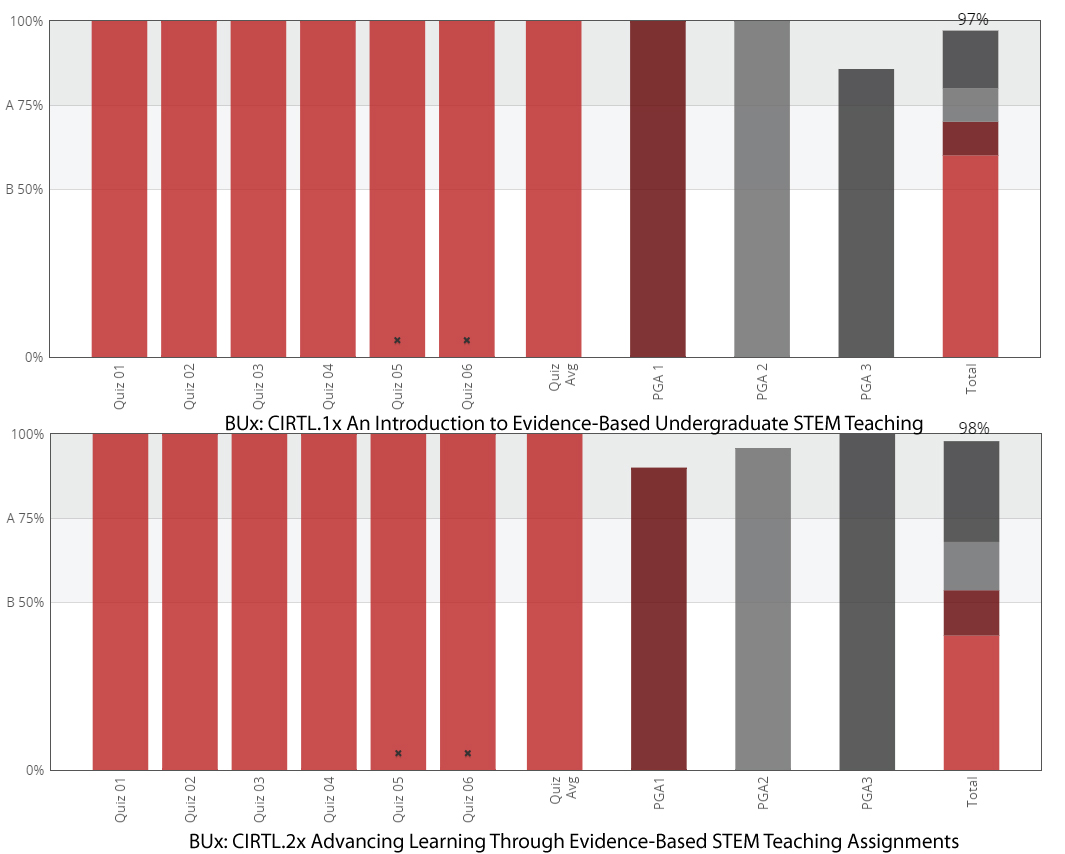CIRTL Evidence-Based Teaching of STEM Students Online Courses
Description
In 2017 I participated in two massive open online courses offered by the Center for the Integration of Research, Teaching, and Learning via edX: Course 1 'An Introduction to Evidence-Based Undergraduate STEM Teaching' and Course 2 'Advancing Learning Through Evidence-Based STEM Teaching'. These courses each involved 12 hours of lecture videos, readings from education research literature, 3 peer-graded assignments, and 6 quizzes culminating in final projects proposing (1) a lesson plan and (2) a Teaching as Research project.
Documentation
2 Certificates of Distinction provided by the CIRTL Network.
Course Description:: Course 1: An Introduction to Evidence-Based Undergraduate STEM Teaching
Topics covered: (P1) Prior knowledge, (P2) Knowledge organization, (P3) Practice & feedback, (P4) Affective domain, Learning objectives, Assessment of learning, Active learning, and Inclusive teaching.
My final course project was a lesson plan for a 2 hour introductory class on eTextiles. The project was adapted for a workshop for 7th graders. Below is a brief excerpt of my CIRTL MOOC 1.x project:
|
OBJECTIVES By the end of this lesson, students should be able to:
... |
|
LEARNING OBJECTIVE 2
|
LECTURE 2. A few slides describing the basics of electric current using a potato + light bulb + alligator clip wires example. The example will slowly be generalized to a battery + LED light + conductive thread. The slides will also include warnings about short circuiting. The lecture slides will include a few examples of circuits that do and do not work, and the instructor will ask for responses from the class to gauge understanding. ACTIVITY 2: Students will diagram a simple circuit using paper and colored pencils. Students will have paper cut-outs of the electronic components necessary to diagram a simple electric circuit (a battery, one LED light, and two different colored pencils to simulate the wires). They will have 5 minutes to work on this task independently, and at the end of the 5-10 minutes, students will discuss with a partner to see if they have the same answer. After 5-10 minutes of pair discussion, students who disagreed with their partners will be asked to report out and present their solutions to the class. MISCONCEPTIONS 2: A common misconception of electric circuits is that the current will continue to flow from the battery and through the light bulb, even if the circuit is open. The behavior can be demonstrated with diagrams in the slides. DIVERSITY 2: (Diversity of ability) Students who have high prior knowledge of electric circuits will obtain additional learning gains by having to explain their responses to their partners. Students with lower prior knowledge will also learn from this task, and from the discussion students of all prior knowledge should learn. ASSESSMENT 2: The Think-Pair-Share activity described above will form an informal peer assessment. The reporting-out discussion should function as a means to provide feedback to all students simultaneously. |
LEARNING OBJECTIVE 3
|
... |
Course Description:: Course 2: Advancing Learning Through Evidence-Based STEM Teaching
Topics covered: Teaching as research, Learning through diversity, Cooperative learning, Peer instruction, Inquiry-based labs, Problem based learning, and The flipped classroom.
My final course project was a Teaching-As-Research project proposal, specifically investigating the use of self-explanation in pre-class quiz questions, and its impact on student learning both in class activities and on more summative assessments.
